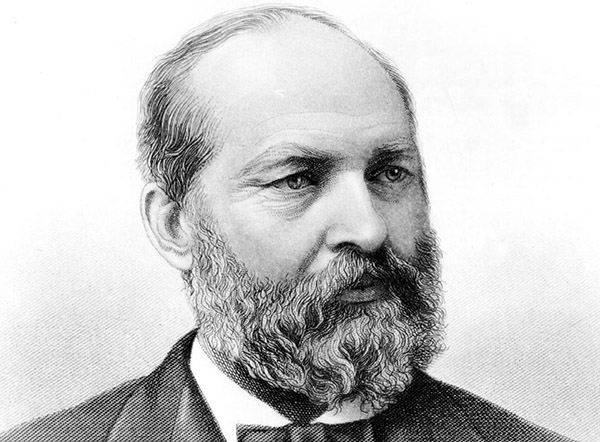Garfield represents an enigma in American history. He was a classics professor, war hero, an opponent of corruption, yet embroiled in judgment questions.
James Abram Garfield was born into a humble family in what might be considered the United States mid-west in 1831. He would come to be an accomplished scholar and teacher at Western Reserve Eclectic Institute (later to be known as Hiram College) in Hiram, Ohio. After several attempts to make the academic community his professional home, he privately studied law and was admitted to the Ohio State Bar in 1860.
Civil War Years
Garfield enrolled as a member of the Ohio volunteer forces and participated in a number of battles and skirmishes in the Ohio Valley as part of the Union forces. It was in 1862, at a battle near Prestonsberg, Kentucky where he distinguished himself and was promoted to the rank of brigadier general. He later fought at the Battle of Shiloh and Battle of Corinth.
Election to Congress
While in the battlefield, Garfield was elected to the United States Congress in October of 1862. Although he did not take his position in Congress, which was in intermittent service during the war years, until late 1863 he would remain as Congressman for the 19th Congressional District of Ohio until 1878. Entering politics had ended James Garfield’s military career.
Ex parte Milligan
Interestingly, in 1866 James Garfield appeared as an attorney for a petitioner before the United States Supreme Court in a case in which Lambdin Milligan and four others were accused of conspiring to take Union war supplies and use them to free Confederate prisoners. The accused were tried in a military court when civilian courts were still in force where the trial was held. It’s quite ironic perhaps that a former major general in the Union Army would act on what he saw as a miscarriage of justice contrary to personal political beliefs.
Not Untainted by Corruption
James Garfield was not untouched by scandal in his political career. In 1872, when the Crédit Mobilier of America scandal broke out revealing that Garfield may have taken bribes from the company involved in the construction of the North American transcontinental railroad there was a hint of scandal but very little political fallout.
Some questions later arose as to the part he had played in the 1876 Presidential Campaign Election Commission which had awarded twenty hotly contested electoral votes to Rutherford B. Hayes over Samuel B. Tilden.
Candidacy, Election, Death
James Abram Garfield turned out to be a “dark horse” at the Republican Presidential Convention. He was well known as the Speaker of the House of Representatives. His opponents were Ulysses S. Grant, who would have been running for an unprecedented third term, and New York Senator Roscoe Conkling and Maine Senator James G. Blaine the latter two ideologically opposed to the way in which government positions, the “patronage system” should be administered.
On the 36th ballot of the convention. Garfield was named as a man promoting civil service reform and Chester A. Arthur, an individual in the civil service, once fired for his patronage practices, became his Vice Presidential candidate.
Ironically, President James Abram Garfield was shot by an unhappy job-seeker and died less than two hundred days after taking office while his Vice President Chester A. Arthur would go on to sign the Pendelton Act, securing civil service reforms.








